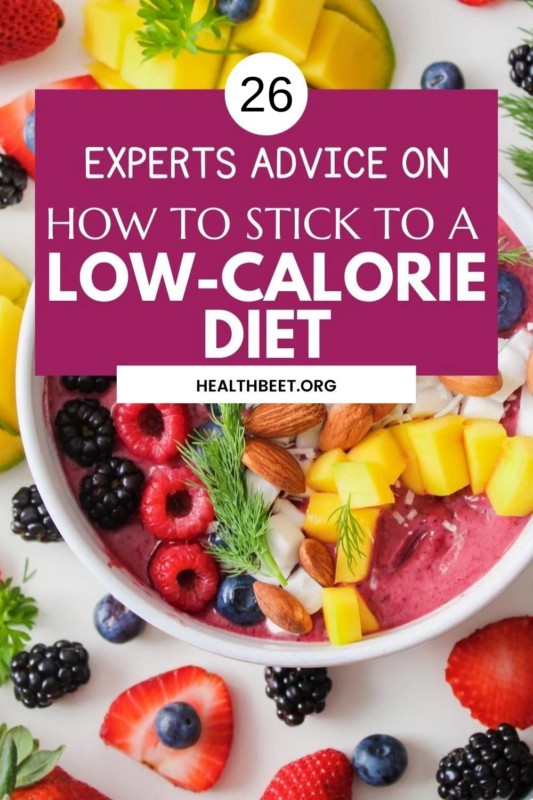How To Stick To A Low-Calorie Diet (Advice from 26 Health and Fitness Experts)
Most people know that in order to lose weight you need to follow a low-calorie diet. There are lots of programs that allow you to be in a calorie deficit, but the really difficult part is sticking to that diet.
So many people start a new diet all the time because they are struggling to change their eating habits. Losing weight it’s not easy, it requires time, effort, and commitment. It can be easy to fall off the wagon if you try doing it alone or unprepared.
We want to help you reach your goals so we asked Minuca Elena to reach out to 26 fitness and nutrition experts and ask them the following question:
What is the best way to stick to a low-calorie diet?
Keep reading to see what the experts had to say.
1) Ted Kallmyer – Healthy Eater

Want to save this post?
Enter your email below and get it sent straight to your inbox.
If you want to lose body fat, your body has to be in a calorie deficit which means eating fewer calories than your body requires to maintain itself. Many people accomplish this through low-calorie dieting which is an effective method as long as it’s done the right way.
First, make sure that your calories aren’t too low. I recommend that people set their calorie deficit at around 20% fewer calories.
This way you’ll be more likely to stick with the diet because it isn’t too restrictive and there’s less risk of your muscle tissue breaking down and thus, slowing down your metabolism.
You can calculate a safe deficit with online calculators and smartphone apps.
Secondly, make sure that you are eating a balanced diet consisting of a good ratio of protein, carbs, and fat.
All three of these macronutrients are important for good health and feeling your best while losing weight and focusing too heavily on one while neglecting the others can cause too much hunger, low energy, and reduce the likelihood that people will stick with their low-calorie diet until they reach their goal weight.
Thirdly, the best way to stick to a low-calorie diet is to track your food intake with a smartphone app.
Food tracking not only creates awareness regarding what you’re eating but also keeps track of the calories you are consuming and alerts you when you are getting close or exceeding your daily limits.
Lastly, make sure that you eat more on the days you exercise.
Exercise places energy demands on your body and many people make the mistake of eating too little on days that they exercise. This creates exhaustion and feelings of starvation which cause many to give up or binge eat.
Make sure that you maintain that 20% calorie deficit on exercise days as well as rest days. By focusing on these four things, you’ll be more likely to stick to your low-calorie diet and get the results that you are looking for.
2) Dr. Ng Kai Lyn – Gynae Patient Info

1. Count your calories
Most people watch their calories in the food they consume but forget about the calories that come with their drinks! Watch what you are consuming in your beverages and cut down on your alcohol intake.
Apps that help with practical calorie-counting are plentiful and easily accessible on your mobile phone when you are on the go.
2. Cook your own food
That’s the only way to know for sure what is going into your food. Experiment with various (healthier) eating methods and watch what you add.
Try to bulk up your meals with plenty of vegetables and protein, and make healthy swaps whenever possible – start by learning to read the food labels in the grocery store – you’ll be surprised at where the hidden calories are!
3. Employ psychological tricks
A huge part of sticking to a low-calorie diet lies in your mind!
Stop junk food from entering the house to prevent easy access, use smaller plates to help with your visual, drink water before your meal, eat and chew slowly to allow food to settle – these are just some simple but effective tricks to get started and ensure success.
3) Dr. Carrie Lam

Calorie Restriction works in multiple mechanisms:
- Increases the ability of the body to repair damaged DNA.
- Decreases oxidative (free radical) damage in the body.
- Increases the levels of certain protective/repair proteins that respond to stress.
- Improves glucose-insulin metabolism by lowering glucose levels in the blood.
- Increases the release of growth hormone from the pituitary gland.
- Increases the production of endogenous antioxidants
Calorie restriction extends life span and is a proven anti-aging tool. There is no doubt about it. Follow the Mediterranean diet in terms of what you should eat.
A simple rule to remember is the 30/90 rule: reduce your calories by 30%, increase vegetable intake to 60%, and reduce your sugar intake by 90%. To avoid malnutrition, take the optimal dosages of your food-based supplements.
4) Summer Yule

It may be easiest to stick to a low-calorie diet if you make the mainstays of your diet nutritious foods that help keep you full for longer. No one likes to be hungry all of the time, so eating in a way you find more filling may be more sustainable.
Many people find foods rich in lean protein, fiber, and water volume helpful in maintaining satiety (i.e., a lasting feeling of fullness).
Some examples of foods rich in one or more of these elements include non-starchy vegetables, broth-based soups, chicken breast, white fish, and berries.
Also, keep in mind that cutting your calories very low without medical supervision is not a good idea. You will likely be hungry all the time on a very low-calorie diet, and you may have more difficulty meeting your essential nutrient needs.
The general recommendation is that women should not regularly go below 1200 calories per day and men should not go below 1500 calories per day without medical supervision.
5) Jessica Formicola – Savory Experiments

Balance is the best way to stick to a low-calorie diet. I don’t ever restrict myself from foods that I want, but I pay extreme attention to portion size and mind my meals for the rest of the day.
When we go out to eat, I share those high-calorie appetizers or desserts with one or two other people. Since my portion size is a little smaller, I opt to take smaller bites too.
This helps me enjoy the indulge longer and also gives my brain time to send signals from my belly to my brain that I am full. I drink at least one full glass of water between each meal.
6) Melissa Eboli – Via Melissa

When it comes to sticking to a low-calorie diet, the best way to achieve this is to follow the principles of a Mediterranean diet.
The reason is, a Mediterranean diet is loaded with fresh vegetables, nuts, grains, seafood, and legumes, and loaded with nutrition. Keeping away from foods that are higher in saturated fat will also result in low calories.
A fat calorie is 8 calories grams versus a carb which is only 4 calories per gram. This doesn’t mean to steer clear of fats altogether though as healthy fats are good for you such as nuts, seeds, avocado, salmon, and coconut.
Eating a decent amount of healthy fat can also lead to fewer calories consumed as healthy fat foods will leave you satisfied and satiated, therefore not craving additional foods and calories to snack on.
7) Dr. Lisa Young

The best way to stick to a diet is first off, not to eat too few calories. I’m more of a fan of a healthy lifestyle program as opposed to a rigid diet.
Eat more fruits and veggies, choose foods you enjoy, eat protein at every meal, and limit ultra-processed foods.
Drink water instead of soda, go easy on alcohol, and practice portion control. All foods fit, but portion size does matter.
8) Erin Palinski-Wade

The best way to reduce your overall calorie intake is by keeping a food record. It is so easy to forget what you ate or be unsure of the portion you consume if you don’t keep track.
By keeping a food record, you can see at a glance what you have actually eaten and how the foods you eat are impacting your overall energy, mood, focus, and even sleep.
Many people feel that keeping a food record is time-consuming, but that is no longer the case, especially when you use an app like MyFitnessPal.
I recommend using this free app, which is the #1 nutrition and food tracker since it has a database of over 14 million foods so you can easily enter or scan food and in seconds have all the nutrition information in front of you.
It couldn’t be easier to keep a daily food record and track your overall nutritional intake and goals.
9) Paula Sturm – Radically Nourished

If a change of weight or body fat is a goal you’re trying to achieve, you’ll need to take a look at how many calories you’re consuming each day.
Likely, you’ll be eating plenty more calories than your body can burn each day resulting in stored fat.
Cutting calories to achieve your body composition goals can be challenging and often uncomfortable.
Let’s look at ways you can cut calories AND feel satisfied at the same time.
Since altering body composition is more than just cutting calories it’s about where those calories are coming from, we’ll discuss how to allocate those calories to amplify your results.
1. Ditch the junk
Calories aren’t created equal. If you’re grabbing processed foods, fast foods, chips, and pastries while steering clear of real, whole, colorful foods, this will be the first area to adjust.
Calories are information, your body is looking for nutrients and messages from your food to inform it what actions to take. Those actions could be beneficial or detrimental.
Nutrient-rich foods give your body the info it needs to support your energy levels, brain health, immune system, muscle mass, etc. Whereas, junk foods jams the signals.
However, your body still needs all these nutrients in order to function properly, so it will signal your appetite to seek out more food in the hopes you’ll pick more nutritious choices.
Choose nutrient-dense, whole foods: an abundance of colorful vegetables and fruit, lean proteins, complex carbohydrates, and healthy fats. Leave behind the packages, the fast food, chips, and sugary desserts.
2. Prioritize Protein
When we eat a lower calorie diet we need to increase the proportion of protein we consume at each meal.
Protein keeps us full and satiated. Whereby refined carbohydrates, like sugar, white flours, candy, cookies, and white pasta do the opposite.
These foods spike your blood sugar and crash shortly after consuming, leaving you hungry and seeking more food.
Protein digests slower and doesn’t have the significant blood sugar impact refined carbohydrates do.
Aim for at least a palm-size portion of lean protein at each meal. Choose foods like chicken, fish, lean beef or pork, or tofu.
3. Fill Up with Fiber
Fiber is incredibly filling! It slows the digestion process while expanding in your GI tract making you feel full. Fiber has little to no-calorie impact on your body since we really don’t digest it.
Fiber’s benefits expand beyond just feeling full. It’s important for cardiovascular health and gut health. Fibers are used as food by our gut microbiome creating health-promoting diversity which can also lead to improved body composition.
Refined and ultra-processed foods are severely lacking in fiber, another reason to steer away from them. Overall, we tend to miss the mark on our daily fiber intake.
Aim for 25-35 grams of fiber a day by choosing whole grains vs refined grains, green leafy veggies, broccoli, cauliflower, apples, flaxseeds, chia seeds, and beans/legumes.
4. Don’t Drink Your Calories
How’s your water intake? Do you shy away from water and towards more “flavorful” options? You could be consuming hundreds of calories just from beverages daily.
These calories offer zero impact on how full and satisfied you feel and may even increase your hunger overall…a double whammy on calorie consumption.
Staying hydrated also helps sway those hunger signals. Oftentimes, when we feel a hunger pang we are actually thirsty, not hungry.
Avoid sodas, all juices, energy drinks, and sports drinks…all those highly flavorful drinks that keep our sweet receptors stimulated. Reach, instead, for water!! Yes, just plain old water.
It will keep you hydrated, energized, mentally alert, and properly burning calories without adding extra calories to your day. Shoot for ½ of your body weight (pounds) in ounces of water each day.
Implementing these four tricks every day will keep you feeling full, satisfied, and energized while following a lower-calorie diet.
10) Jane Lamason

My top five tips are:
1. Record what you eat. Keep a food journal or use a tracking app to log your intake. This will help you stay accountable and see where you might need to make changes.
2. Include healthy fat in your diet. Fat doesn’t make you fat – overindulging in unhealthy fats does. Including healthy fats in your diet can help with weight loss. Healthy fats like olive oil, avocado, and nuts provide satiety and help keep you feeling fuller for longer
3. Make healthy swaps when you can: swap rice and couscous for cauliflower rice, pasta for vegetables, and bread for grain-free versions.
4. Get enough sleep. If you’re not well-rested, you have more cravings for unhealthy foods. And studies have found that not enough sleep increases the risk of overindulging in unhealthy food choices.
5. Stress can also affect calorie intake. When you’re stressed, your body releases excess amounts of the hormone cortisol, which can increase your appetite and lead to overeating. If you’re looking to lose weight, try using meditation or taking part in a relaxing activity like yoga to help keep stress levels in check.
11) Julie Mancuso – JM Nutrition

1. Use a gradual approach. In other words, start with three significant changes. Don’t uproot everything you’re currently doing.
Trying to change everything all at once can make you feel overwhelmed. Three changes are doable. Once these become an ingrained habit, introduce more.
2. Make sure that what you’re eating is personalized to your food preferences, lifestyle, dietary conditions, religious restrictions, and budget.
All the boxes must be ticked off to set the stage for long-term success. We’re all made differently with different dispositions, and as such, the action plan should reflect this.
3. Find healthier, lower-calorie substitutions for your favorite foods. Completely eliminating all the foods you enjoy eating will swiftly lead to feelings of deprivation, then frustration, and eventually, abandonment.
Enjoyment will breed sustainability.
4. Start implementing practical strategies to help sustain the low-calorie diet. Eat a breakfast consisting of fiber and protein–both will help you feel full for longer.
If you have trouble resisting high-calorie highly palatable foods during the morning coffee break or at a party, limit exposure to these situations.
You can also ensure healthy, low-calorie snacks are readily accessible, in clear packaging, and within reach.
Conversely, keep high-calorie foods out of sight, out of reach, and in opaque containers. Our minds follow the path of least resistance, so let it work for you.
12) Robert Herbst – Weight Lifter

The best way to stick to a low-calorie diet is to eat a balanced diet, but just eat less of it. You should not cut out a certain food group such as pasta or a type of food such as dessert because you will feel as if you are denying yourself and the diet will become a chore.
Instead, just have smaller portions or less calorie-dense portions. For example, you could eat fruit with whipped cream instead of double chocolate cake for dessert.
Eat plenty of lean protein such as chicken, fish, or vegetables. This will make you feel full and prevent muscle wasting during weight loss.
Also, watch the extras. Instead of having a daily 500 calorie grande latte at a premium coffee shop, try a specialty tea with lemon to get your caffeine fix. Maybe just have the grande latte once or twice a week for variety.
If you feel hungry, drink water. It will fill you up and keep you hydrated. Your hunger could actually be a sign of thirst in the first place.
Your diet should be supported by an exercise program such as strength training which keeps your metabolism elevated. This will counter your body’s tendency to slow things down to conserve calories. Plus you will look fit as the fat disappears.
13) Donna Rose – Nona’s Nutrition Notes

In my experience, clients trying to stick to a low-calorie diet found it was most helpful to keep a food journal.
By writing down everything you eat, you learn more about your food habits while keeping track of calories.
Food journaling makes you more mindful of what you are eating.
Include the time of day you eat and make a note of how you are feeling and why you are eating. This helps you realize if you’re eating out of boredom rather than hunger.
Food journaling also allows you to see when you’re NOT eating enough calories, and are cutting back too much, in an effort to achieve rapid weight loss.
Depriving yourself of sufficient calories will ultimately lead to overindulging and sabotage your weight loss efforts.
Set reasonable goals and accept that there will be setbacks. Don’t allow yourself to feel like a failure if you have a bad day. Include exercise, be patient, and you will see results.
14) Kelsey Riley – Planted In The Kitchen

The best way to stay on track when maintaining a calorie deficit is to fill your diet with a variety of nutrient-dense foods.
While it might be tempting to turn to food items such as chips, cookies, and other highly processed foods for convenience, they will probably leave you feeling hungry in just a short period of time.
When you choose foods like fruits, vegetables, nuts, beans, legumes, and whole grains, you’re fueling and nourishing your body, even when you are in a calorie deficit.
Rather than leaving you hungry and lacking energy, these foods will help power your day and leave you full and satisfied.
I recommend planning your meals and snacks in advance and meal prepping at the beginning of the week.
Doing this will ensure that you have a variety of healthy and delicious food options readily available to you all throughout the week. This can help you stay on track and can help you reach your goals when eating a lower-calorie diet.
15) Dr. Tom Biggart – EBM Fitness Solutions

The best way to stick to a low-cal diet is to realize that no diet is a long-term solution. It must have a beginning and an end.
Have a specific goal and a specific amount of time you will follow the caloric restriction.
Having a start and an end will help you get your mind focused. Your mind will play tricks on you and if you are not mentally prepared for the caloric restriction, it will be harder than it has to be.
Understand that you are going to be hungry often since your calories are low. Learn to get comfortable being a little hungry. Again, this is why the plan has to have a specific goal and a specific time frame.
If you don’t already, this might be a good time to take a multivitamin and/or a greens supplement to try to avoid developing deficiencies in important vitamins and minerals.
As with all things nutrition-related, pay attention to how your body feels and the feedback it is giving you. Adjust your calories as needed.
16) Jacqueline Keller – Nutri Fit Online

The first rule – above all else, keep it realistic. You can’t starve your way to weight loss.
Depriving the body of adequate calories puts you at risk of inadvertently setting off a slowing of your metabolism to conserve energy, instead of burning calories.
As a general rule, most people need a minimum of 1,200 calories daily to stay healthy. It goes up from there, depending on height and activity level.
Choose calories carefully, maximize the nutritional value of the foods you eat by consuming plenty of plants (fruits and vegetables) that are high in moisture and fiber. Select proteins that are lean and carbohydrates that are favorable, and an adequate amount of healthy fats.
It’s also helpful to have a partner or friend that you can talk to about the challenges you face with adherence. Social support is very important.
Set small achievable and realistic goals that you can measure. This will help you stay motivated. And most importantly, remember to celebrate the successes along the way. It’s a process, and processes take time.
17) Allison Jackson Fitness

The best way to stick to a low-calorie diet is to create your own meal plan for the week. Having an outline to follow, will help you stay on track and ensure you are eating within your targeted calorie range.
The best way to do this is by downloading a free nutrition tracking app like MyFitnessPal. All you need to do is enter your meals into the app to see the calories in the foods you select.
From there you can create meals to fit your calorie target. Be sure to prioritize protein in each meal and snack. Not only will this macronutrient help keep you full, you’ll also help retain muscle while dieting down.
It’s also important to only follow a low-calorie diet for a short period of time. Staying on a low-calorie diet for too long can negatively impact your metabolism.
18) Phung Tran – Be Active is Easy

The best way to stick to a low-calorie diet is not thinking about the low-calorie diet as something special.
You need to make the low-calorie diet as part of your normal diet, one that you eat for most days of the year, not some kind of fads that you only follow in January and abandon in February.
To be successful in keeping up with your low-calorie diet, you should make your plan reasonable, meaning starting at an easy level and slowly advancing to your ideal stage.
That way, you can make a low-calorie diet a natural part of your daily life, and not something you have to put effort toward.
19) Shahada Karim – Habibi Body Sport

The best way to stick to a low-calorie diet is with plant-based whole foods. Get familiar with the produce section of your local grocery store. You can put together incredible meals using just the ingredients in that part of the store.
The best part about vegetables is that you can eat them with abandon. They tend to be on the lighter side calorically, but are still delicious and very filling.
Explore your options with fruit as well. Avoid fruit juices, because the sugar rush can flood your body and leave you hungry and unsatisfied. Instead, eat the fruit in its whole form so that your body processes fruit sugar, and fiber in a balanced way.
Stay away from processed foods because they tend to be calorie-dense and unfulfilling. They typically require portion control to maintain a lower caloric intake.
Animal proteins and animal-based products can carry a high fat load and can increase cholesterol to harmful levels. So eat vegetables with abandon, fruit, and grains in balance, and legumes for protein.
20) Alex Davis – Ryan and Alex Duo Life

Starting a low-calorie diet can seem daunting at first. Our advice is to take it day-by-day, especially for the first two weeks while your body is adjusting. This is the time you’ll experience the most hunger pangs but know that there is a light at the end of the tunnel.
By the end of the first month, your body should have adjusted as long as the calorie deprivation isn’t so severe. Research has found that starting with a 25% calorie reduction is a sustainable tactic.
Another method that we recommend with a low-calorie diet is to pair it with intermittent fasting.
Keeping a relatively simple schedule, but skipping one meal such as breakfast, will help maintain an easy routine, while still giving you the many known benefits of fasting.
Generally, we still recommend that women consume no less than 1,200 calories per day and 1,600 calories for men.
Also, never consume less than your BMR (basal metabolic rate) as it could cause your metabolism to plummet and weight loss to yo-yo.
21) Tommy Vekhayn

The best way to stick to a low-calorie diet is to stay busy. Simply put, when we don’t do anything- our ‘hunger’ signal goes crazy. Our bodies have evolved over millions of years to get angry with you if you’re hungry and you’re not doing anything about it.
You need to think of the days we were just hunters and gatherers, when we were on the move, our bodies didn’t give us those hunger signals because they wanted us to focus on finding food.
Today, even though we have food available basically anywhere we go, our bodies still do the same thing. If you’re hungry and you’re not focused on anything else, you will have a hard time sticking to the low-calorie diet as that feeling will overwhelm you.
When you stay busy, you won’t feel that ‘hunger’ sensation as much- even if it is always a little bit present.
Some ways you can stay busy include: studying, working, going on a walk, and hanging out with friends.
This is one of the reasons I like doing those low-calorie diets around the summertime. Going to the beach all day and playing sports makes the time go by quickly and makes you forget you’re on that diet at all.
So, go grab some of your friends and go to the beach, lake, or even just to the local park. Play some sports, meet some friends, and by the end of the day, you’ll notice that the low-calorie diet is much more manageable when your mind is off of it.
22) Ashley Wood – Demystifying Your Health

The best way to stick to a low-calorie diet is to keep track of what you’re consuming. Awareness is key! Next, make sure your calories are coming from nutritious sources to provide your body with the proper nutrition it needs.
The last thing is picking food items that you enjoy eating. Otherwise, after a while, you won’t stick with the diet because you feel like you’re missing out.
If you feel super hungry in between meals, try drinking water or other beverages that don’t contain calories because this can help you feel full until your next meal.
Plus, we often mistake hunger for thirst, so by taking in water, you’ll prevent this from happening.
Also, it’s helpful to plan one day each week where you go above your calories because this means you can enjoy things that aren’t typically on your diet. Just remember not to go crazy, or you’ll undo all your hard work.
23) Elizabeth Girouard – Pure Simple Wellness

As a Certified Health Coach and Emotional Eating Expert, I don’t recommend low-calorie diets for an extended period of time.
Extremely low-calorie diets can slow down your metabolism, which makes it harder to lose weight and keep it off. In addition, it doesn’t teach you healthy habits for the long term.
If you choose to follow a low-calorie diet for the short term, here are a few simple tips to help you stick with it:
Eat real foods: Focus on eating fruits, vegetables, nuts, seeds, legumes, eggs, and animal proteins which provide nutrients to fuel your body and provide energy to your cells.
Eat lots of low-starch veggies such as broccoli, brussels sprouts, leafy greens, and cauliflower to keep yourself full, without lots of added calories.
Hydrate your body. Sometimes you can mistake thirst for hunger. When you first feel the hint of hunger, drink a glass of water and wait 15 minutes before you eat.
Sometimes, the water will keep you going for another hour or two and it keeps you feeling full longer.
Maintain muscle mass: Eat adequate amounts of protein to maintain your muscle mass while on a low-calorie diet.
In addition, muscle burns more calories than fat. Do resistance training while you are dieting to avoid losing muscle as you drop weight and potentially increase your muscle mass.
Avoid liquid calories: Avoid beverages with lots of sugar and excess calories, like coffee drinks, soda, lemonade, vitamin water, beer, and iced tea.
Instead, drink zero-calorie beverages like water, sparkling water, herbal and green teas, and black coffee. A Starbucks Mocha Frappuccino packs in a whopping 410 calories – perhaps more than ¼ of your daily calories in one drink!
Watch your portions: The calories from certain foods like nuts, seeds, and potatoes can add up.
Even though these foods can be part of a healthy diet, it’s important to measure out these foods, so you don’t accidentally eat an extra 300 calories of almonds. These foods are best avoided directly from the bag!
24) James Shapiro

The best way to stick to a low-calorie diet is to set up a rotation or lineup of foods that you know you can go to stay within your caloric and macronutrient goals.
Most people believe that eating in a caloric deficit means eating smaller portions and bland food. On the contrary, if you can find a selection of meals that you can easily prepare & easily flavor up with different spices and veggies.
Once you have your rotation of meals, it’s not easy to get bored because as your meal preparation for one week ends, you can look forward for the other meals.
The second half of that equation is staying with macronutrient goals. Most people focus on carbs, but neglect protein intake. It is the only macronutrient that is not used as a source of energy for the body.
Increasing your protein intake also increases your level of satiety or fullness. If you feel full from more protein intake, you’ll be less likely to search for snacks and empty calories throughout the day.
25) Emily Countryman – Ideal Wellness

The best way to stick to a low-calorie diet is to consume the foods that will pack the biggest nutritional punch. Aim for foods with a high nutritional value, like dark green vegetables and lean proteins like eggs, tofu, chicken, turkey, or fish.
These foods will help fill you up and fuel you up. Beyond picking the right foods, you will also want to know your why. Why are you changing your meals? Is it for a health goal, a weight loss goal, a goal to enjoy daily activities more?
Challenges will come at you each day to deter you from your eating plan, so if you don’t have a strong why you may easily get taken off course.
Determine your why and repeat your mantra daily, add it to your bathroom mirror or your phone screen to look at it often to help keep you focused on your goals.
Choosing nutrient-dense foods and recognizing your motivation for eating a low-calorie diet will help you be successful long-term.
26) Maxwell Kamlongera – Mx Fitness World

Assuming you’ve done your homework correctly and you’ve managed to build or find a low-calorie diet that meets your caloric goals, then the best way to stick to the diet is by ensuring that you’re enjoying what you’re eating.
A lot of the rich tastes and flavors we enjoy in meals come from either fats, sugars, or both. Low-calorie foods are usually low in these items, hence why it’s challenging to enjoy meals like a salad that doesn’t “taste as great”.
Instead of forcing yourself through a meal, you’re not enjoying simply because it’s low in calories, find and select low-calorie food items that you take pleasure in.
This will require more time and research on your part in finding those food items and building them into a working diet, but the tradeoff is meals won’t feel a chore, and your diet won’t feel like a “diet” but a lot closer to normal, every day eating.
Thank you so much to all the experts that have contributed to this expert roundup! Please share this post with your friends and family on social media.
Pin for later!






